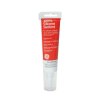- Aug 7, 2017
- 418
- 225
This is how you open up a HFW series bullet camera when you have condensation.
(I bought two of these HFW-1831E from Andy and placed them side-by-side next to each other to capture a full 180 degree FOV. It rained for 3 days and one of them suddenly developed condensation and the problem would not get better. The other one for some reason is still okay. Most likely I think this camera is exposed to direct sunlight when the rain clears and this causes temperature variation.)

1. Pry open the piano-black face plate gently. It is glued on. Do not pull upwards but use a tiny flat head and insert deep into the base and then lift up slowly. The piano black face plate is plastic and may crack.

2. Remove 4 screws as shown.

3. The cover should now fall off. Disconnect the white connector.

4. Remove two screws on opposite side of each other. Then you can gently pull and slide out the entire camera circuitry from the housing. But do not pull hard, the circuitry is still wired to the pigtail at the back. You can now clean, dust off, and replace desiccant.

(I bought two of these HFW-1831E from Andy and placed them side-by-side next to each other to capture a full 180 degree FOV. It rained for 3 days and one of them suddenly developed condensation and the problem would not get better. The other one for some reason is still okay. Most likely I think this camera is exposed to direct sunlight when the rain clears and this causes temperature variation.)

1. Pry open the piano-black face plate gently. It is glued on. Do not pull upwards but use a tiny flat head and insert deep into the base and then lift up slowly. The piano black face plate is plastic and may crack.

2. Remove 4 screws as shown.

3. The cover should now fall off. Disconnect the white connector.

4. Remove two screws on opposite side of each other. Then you can gently pull and slide out the entire camera circuitry from the housing. But do not pull hard, the circuitry is still wired to the pigtail at the back. You can now clean, dust off, and replace desiccant.

Last edited:


